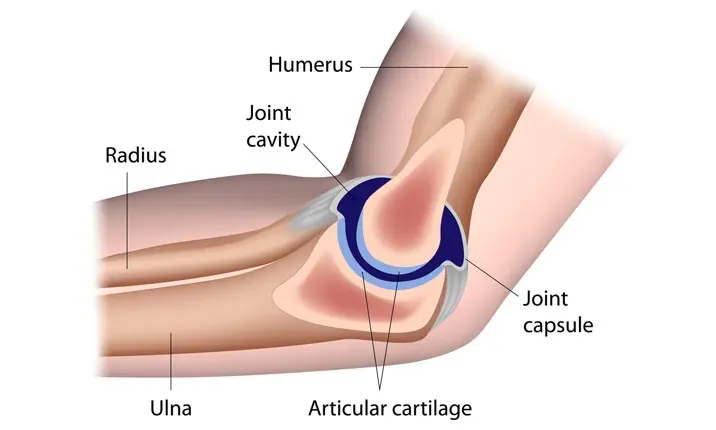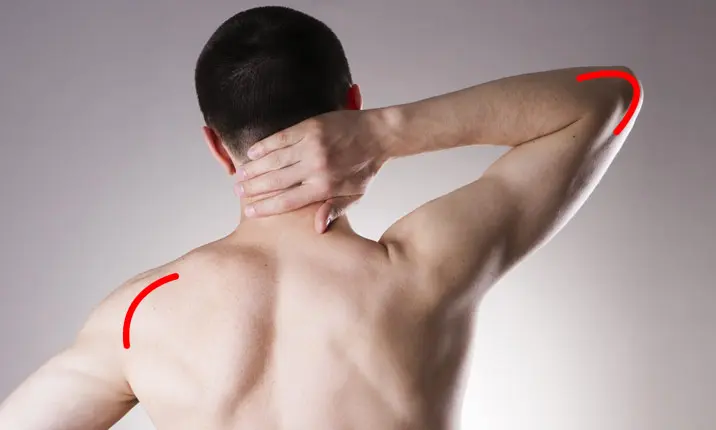Ask any orthopaedic surgeon what the top 10 sports injuries they treat are and chances are the elbow and shoulder will be high on the list. Your joints are more susceptible to injury than other areas of the body. For one thing, they are fairly exposed, with less tissue or fat to protect them, but more importantly they usually take the force of any impact. Those who play contact sports, such as wrestlers, often find their elbow or shoulder directly in the line of fire, especially during a tackle.
Your shoulder joint
Your shoulder is the point at which your upper arm bone, known as the humerus, meets your shoulder blade, also known as the scapula. The rotator cuff is made up of muscles and tendons that support the joint, and there is fluid in a small sac called a bursa surrounding the joint and protecting the rotator cuff.
Common injuries to the shoulder include:
- A rotator cuff injury, usually a tear to the muscles and tendons
- Dislocation, where one of the bones, usually the humerus, pops out of place
- Tear to the cartilage, known as the labram, that protects the head of the humerus
- Less serious injuries such as impingement, inflammation of the bursa, or strains and sprains
Your elbow joint
Your elbow is the point at which three arm bones meet; the ulna and radius from the lower arm, and the humerus from the upper arm. Cartilage and fluid help the joint move smoothly, and tendons and muscles keep the elbow stable.
Common injuries to the elbow include:
- A fracture, which involves broken bones, sometimes all three
- Dislocation, where the bones pop out of place, often as a result of falling onto your hands
- Sprains, which are very common with athletes
- Tennis elbow, which is inflammation of the tendons
Surgery for your elbow or shoulder
If you play intense contact sports, injuries to these areas of the body can be severe. Mixed martial arts (MMA) for example, has an injury incident rate of around 25%. Certain disciplines of MMA are more likely to result in joint injuries, such as jiu-jitsu and wrestling. Other contact sports such as American football, rugby, and ice hockey, can also leave players prone to serious joint injuries. The force of impact within these disciplines is enough to cause dislocations, breaks and tears that require surgery.
Types of surgery
Depending on your injury, your surgeon will utilise different surgical techniques to repair and stabilise your joints.
Traditional open surgery
During traditional surgery, the surgeon has to make a large incision. Through this opening they will perform the required procedure. Depending on your injury, they may need to remove an inflamed bursa (fluid sac), repair tendons, repair a fracture or reset the bones. Traditional open surgery typically involves a longer hospital stay, because it usually involves a general anaesthetic and needs more stitches. Blood loss can also increase and the risks associated with open surgery are often greater. After you leave hospital, the recovery can be lengthy, and you might need long-term physiotherapy to get your strength and full range of movement back.
Minimally invasive surgery (MIS)
Arthroscopy (also called arthroscopic or keyhole surgery) is a minimally invasive surgical procedure on a joint in which an examination and sometimes treatment is performed using an arthroscope, an endoscope or a flexible tube with a light and camera attached to it that is inserted into the joint through a small incision. Minimally invasive surgery has many benefits. Your surgeon can shave down the joint, repair breaks and tears, and improve joint function, all through this small keyhole. Many surgeons now prefer to carry out their procedures this way. The other benefits of going for a MIS include:
- Surgery can be performed as an outpatient procedure, without the need for a hospital stay
- Local anaesthetic can be used instead of general anaesthetic, lowering the risk of complications
- Small incision means fewer stitches and smaller scars
- Much shorter recovery time so you can return to your sport as soon as possible
- Lower risks in general, meaning it is safer than open surgery for most people
- Less painful side effects during recovery
Should you talk to your doctor about MIS?
It's important to advocate for your own health, especially if you are an athlete or sports player that relies on your body performing at its best. Orthopaedic specialists and sports surgeons often prefer minimally invasive techniques because they offer a quick recovery time for athletes to get back to top form. However, there are cases where MIS is not an option and open surgery is the only way to repair the damage. This tends to be if the injury is severe, or you have experienced a recurring issue and the joint has worsened over time. It's important not to wait if you do have an injury that could be improved by MIS. If you put it off too long it may no longer be a viable option.
Keep your body fighting fit
Staying in peak health and resolving issues quickly will help you to continue to play the sports you love for as long as you want to. Make sure you warm up effectively, take part in conditioning sessions in between intense events, and keep your muscles and bones strong with a healthy, balanced diet. You can talk to your doctor about recommended supplements and dietary advice for keeping your joints strong. If you are injured, or have previously been injured and are in a lot of pain, ask your healthcare provider about MIS to see if it's right for you.

















